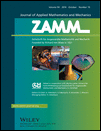Journal list menu
Export Citations
Download PDFs
Cover Picture
Issue Information
Contents
Editor's Choice
A hybrid stochastic Galerkin method for uncertainty quantification applied to a conservation law modelling a clarifier-thickener unit
- Pages: 793-817
- First Published: 29 July 2013

The continuous sedimentation process in a clarifier-thickener can be described by a scalar nonlinear conservation law for the local solids volume fraction. The flux density function is discontinuous with respect to spatial position due to feed and discharge mechanisms. Typically, the feed flow cannot be given deterministically and efficient numerical simulation requires a concept for quantifying uncertainty. In this paper uncertainty quantification is expressed by a new hybrid stochastic Galerkin (HSG) method that extends the classical polynomial chaos approximation by multiresolution discretization in the stochastic space.
Original Papers
Asymptotic decomposition in the problem of joined elastic beams
- Pages: 818-836
- First Published: 17 June 2013

The analysis of problem of joined elastic beams is presented in comparison with the engineering and asymptotic approaches. The analysis is based on three-dimensional elasticity theory model and recently developed method of local perturbation [Gaudiello and Kolpakov, Int. J. Eng. Sci. 49, 295–309 (2011)], which seems to be an effective tool for analysis of fields in the vicinity of joint. Due to the strong localization of perturbation of solution, computation of local strains and stresses in the vicinity of joint can be realized with standard FEM software.
A theory of thermoelasticity with diffusion under Green-Naghdi models
- Pages: 837-852
- First Published: 02 July 2013
The authors use the Green-Naghdi theory of thermomechanics of continua to derive a nonlinear theory of thermoelasticity with diffusion of types II and III. This theory permits propagation of both thermal and diffusion waves at finite speeds. The equations of the linear theory are also obtained. With the help of the semigroup theory of linear operators they establish that the linear anisotropic problem is well posed and they study the asymptotic behavior of the solutions.
Stress intensity factor for an infinite plane containing three collinear cracks under compression
- Pages: 853-861
- First Published: 29 July 2013

Considering crack surface friction and using complex stress function theory, the exact analytical solution of stress intensity factors (SIFs) for an infinite plane containing three collinear cracks is obtained. The effects of confining stresses, crack distances and the crack surface frictions on SIFs are analyzed through the theoretical results and the Abaqus code. A photoelastic experiment was conducted to validate the theoretical result about the effect of confining stresses.
A microscale second gradient approximation of the damage parameter of quasi-brittle heterogeneous lattices
- Pages: 862-877
- First Published: 29 July 2013

Lattice models are powerful tools to investigate damage processes in quasi-brittle material by a microscale perspective. This paper explores the connection between the series of critical strains at which the microcracks form (i.e. lattice links fail) and the second gradient of the microscale displacement field. Note worthy, the results support the new view that the damage evolution is a three regimes process (I dilute damage, II homogeneous interaction, III localization.) The featured connection with the second gradient of the microscale displacement field is applicable in regions II–III, where microcracks interactions grow stronger and the lattice transitions to the softening regime.
Harmonic vibrations of nanosized piezoelectric bodies with surface effects
- Pages: 878-892
- First Published: 29 July 2013
For harmonic problem new mathematical model is suggested, which generalizes the model of the piezoelectric medium with damping properties, boundary conditions of contact type and surface effects. The classical and generalized (weak) statements for harmonic and eigenvalue problems are formulated in the extended and reduced forms. The spectral properties of the eigenvalue problems with account for surface effects are determined. A variational minimal principle is constructed which is similar to the well-known variational principle for problems for pure elastic and piezoelectric media.






1521-4001.zamm100years.cover.gif)